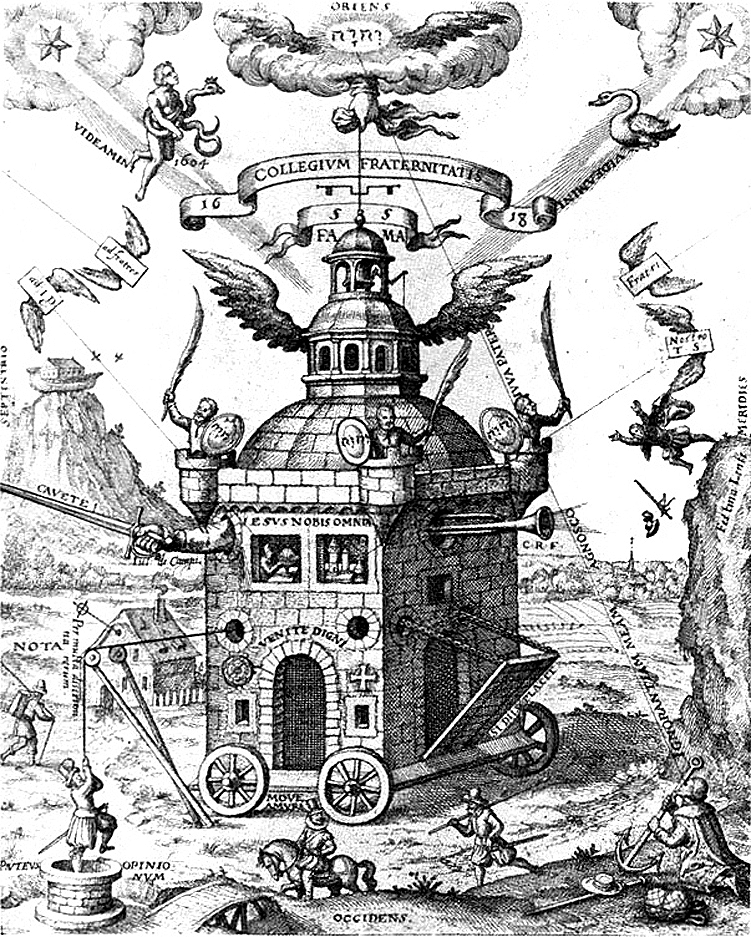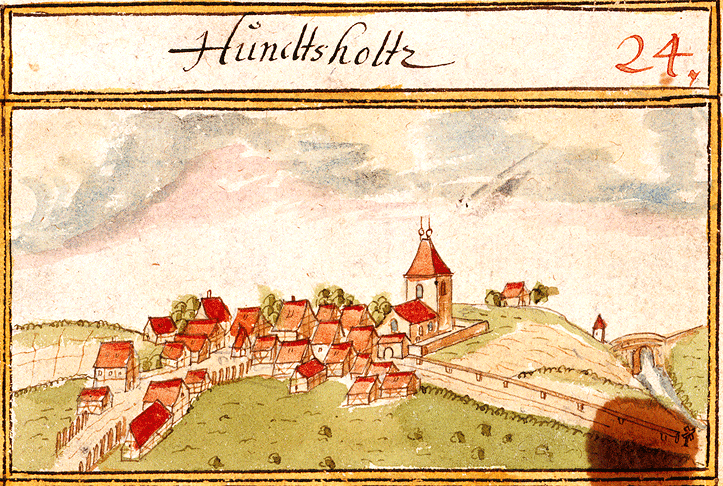|
Johannes Valentinus Andreae
Johannes Valentinus Andreae (17 August 1586 – 27 June 1654), a.k.a. Johannes Valentinus Andreä or Johann Valentin Andreae, was a German theologian, who claimed to be the author of an ancient text known as the ''Chymische Hochzeit Christiani Rosencreutz anno 1459'' (published in 1616, Strasbourg; in English '' Chymical Wedding of Christian Rosenkreutz in 1459''). This became one of the three founding works of Rosicrucianism, which was both a legend and a fashionable cultural phenomenon across Europe in this period. Andreae was a prominent member of the Protestant utopian movement which began in Germany and spread across northern Europe and into Britain under the mentorship of Samuel Hartlib and John Amos Comenius. The focus of this movement was the need for education and the encouragement of sciences as the key to national prosperity. But like many vaguely-religious Renaissance movements at this time, the scientific ideas being promoted were often tinged with hermeticism, occ ... [...More Info...] [...Related Items...] OR: [Wikipedia] [Google] [Baidu] |
Herrenberg
Herrenberg (Swabian German, Swabian: ''Härrabärg'' or ''Haerebärg'') is a town in the middle of Baden-Württemberg, about 30 km south of Stuttgart and 20 km from Tübingen. After Sindelfingen, Böblingen, and Leonberg, it is the fourth largest town in the district of Böblingen (district), Böblingen. Location Herrenberg is situated on the western edge of the Schönbuch forest and is a central town within the Gäu region. The Stiftskirche, which houses the Glockenmuseum (bell museum), is a tourist attraction in the main square. The following towns and municipalities border Herrenberg. They are listed in clockwise direction beginning in the north: Deckenpfronn, Gärtringen, Nufringen, Hildrizhausen and Altdorf, Böblingen, Altdorf (all Böblingen district), Ammerbuch (Tübingen district), Gäufelden and Jettingen (both Böblingen district) as well as Wildberg, Baden-Württemberg, Wildberg (Calw district). History The once small community Herrenberg was formed out of ... [...More Info...] [...Related Items...] OR: [Wikipedia] [Google] [Baidu] |
Vaihingen An Der Enz
Vaihingen an der Enz is a town located between Stuttgart and Karlsruhe, in southern Germany, on the western periphery of the Stuttgart Region. Vaihingen is situated on the river Enz, and has a population of around 30,000. The former district-capital is now part of the district of Ludwigsburg in the ''Land'' (state) of Baden-Württemberg. It is 25 km northwest of Stuttgart, and 15 km west of Ludwigsburg. Not to be confused with Vaihingen, a district of Stuttgart. Location Vaihingen lies at an altitude of 200 to 450 metres at the end of the Strohgäus, on the western edge of the Neckarbecken in a valley widening of the Enz. The town centre lies on the east side of the river and is overlooked by the castle Kaltenstein. History Vaihingen may date back as far as 799 AD, but the documents are not clear. In 1252 documents refer directly to Vaihingen as a town, established by Count Gottfried von Vaihingen. The town changed hands several times. In the sixteenth century it bec ... [...More Info...] [...Related Items...] OR: [Wikipedia] [Google] [Baidu] |
Johannes Saubert Der Ältere
Johannes is a Medieval Latin form of the personal name that usually appears as "John" in English language contexts. It is a variant of the Greek and Classical Latin variants (Ιωάννης, ''Ioannes''), itself derived from the Hebrew name '' Yehochanan'', meaning "Yahweh is gracious". The name became popular in Northern Europe, especially in Germany because of Christianity. Common German variants for Johannes are ''Johann'', ''Hannes'', '' Hans'' (diminutized to ''Hänschen'' or ''Hänsel'', as known from "''Hansel and Gretel''", a fairy tale by the Grimm brothers), '' Jens'' (from Danish) and ''Jan'' (from Dutch, and found in many countries). In the Netherlands, Johannes was without interruption the most common masculine birth name until 1989. The English equivalent for Johannes is John. In other languages *Joan, Jan, Gjon, Gjin and Gjovalin in Albanian *'' Yoe'' or '' Yohe'', uncommon American form''Dictionary of American Family Names'', Oxford University Press, 2013. *Yaḥy ... [...More Info...] [...Related Items...] OR: [Wikipedia] [Google] [Baidu] |
Astrology
Astrology is a range of Divination, divinatory practices, recognized as pseudoscientific since the 18th century, that claim to discern information about human affairs and terrestrial events by studying the apparent positions of Celestial objects in astrology, celestial objects. Different cultures have employed forms of astrology since at least the 2nd millennium BCE, these practices having originated in Calendrical calculation, calendrical systems used to predict seasonal shifts and to interpret celestial cycles as signs of divine communications. Most, if not all, cultures have attached importance to what they observed in the sky, and some—such as the Hindu astrology, Hindus, Chinese astrology, Chinese, and the Maya civilization, Maya—developed elaborate systems for predicting terrestrial events from celestial observations. Western astrology, one of the oldest astrological systems still in use, can trace its roots to 19th–17th century BCE Mesopotamia, from where it spr ... [...More Info...] [...Related Items...] OR: [Wikipedia] [Google] [Baidu] |
Alchemy
Alchemy (from Arabic: ''al-kīmiyā''; from Ancient Greek: χυμεία, ''khumeía'') is an ancient branch of natural philosophy, a philosophical and protoscientific tradition that was historically practiced in China, India, the Muslim world, and Europe. In its Western form, alchemy is first attested in a number of pseudepigraphical texts written in Greco-Roman Egypt during the first few centuries AD.Principe, Lawrence M. The secrets of alchemy'. University of Chicago Press, 2012, pp. 9–14. Alchemists attempted to purify, mature, and perfect certain materials. Common aims were chrysopoeia, the transmutation of "base metals" (e.g., lead) into "noble metals" (particularly gold); the creation of an elixir of immortality; and the creation of panaceas able to cure any disease. The perfection of the human body and soul was thought to result from the alchemical ''magnum opus'' ("Great Work"). The concept of creating the philosophers' stone was variously connected with all of the ... [...More Info...] [...Related Items...] OR: [Wikipedia] [Google] [Baidu] |
Ludibrium
Ludibrium is a word derived from Latin ''ludus'' (plural ''ludi''), meaning a plaything or a trivial game. In Latin ''ludibrium'' denotes an object of fun, and at the same time, of scorn and derision, and it also denotes a capricious game itself: e.g., ''ludibria ventis'' (Virgil), "the playthings of the winds", ''ludibrium pelagis'' (Lucretius), "the plaything of the waves"; ''Ludibrio me adhuc habuisti'' (Plautus), "Until now you have been toying with me." The term "ludibrium" was used frequently by Johann Valentin Andreae (1587–1654) in phrases like "the ludibrium of the fictitious Rosicrucian Fraternity" when describing the Rosicrucian Order, most notably in his ''Chymical Wedding of Christian Rosenkreutz'', published anonymously in 1616, of which Andreae subsequently claimed to be the author and which has been taken seriously, as virtually a third of the Rosicrucian Manifestos. However, in his ''Peregrini in Patria errores'' (1618) Andreae compares the world to an amphithe ... [...More Info...] [...Related Items...] OR: [Wikipedia] [Google] [Baidu] |
Chymical Wedding Of Christian Rosenkreutz
The ''Chymical Wedding of Christian Rosenkreutz'' (german: Chymische Hochzeit Christiani Rosencreutz anno 1459) is a German book edited in 1616 in Strasbourg. Its anonymous authorship is attributed to Johann Valentin Andreae. The ''Chymical Wedding'' is often described as the third of the original manifestos of the mysterious "Fraternity of the Rose Cross" (Rosicrucians), although it is markedly different from the ''Fama Fraternitatis'' and ''Confessio Fraternitatis'' in style and in subject matter. It is an allegoric romance (story) divided into Seven Days, or Seven Journeys, like Genesis, and recounts how Christian Rosenkreuz was invited to go to a wonderful castle full of miracles, in order to assist the Chymical Wedding of the king and the queen, that is, the ''husband'' and the ''bride''. This manifesto has been a source of inspiration for poets, alchemists (the word "chymical" is an old form of "chemical" and refers to alchemy—for which the 'Sacred Marriage' was the goal ... [...More Info...] [...Related Items...] OR: [Wikipedia] [Google] [Baidu] |
Rosicrucian
Rosicrucianism is a spiritual and cultural movement that arose in Europe in the early 17th century after the publication of several texts purported to announce the existence of a hitherto unknown esoteric order to the world and made seeking its knowledge attractive to many. Yates, Frances A. (1972), ''The Rosicrucian Enlightenment'', London The mysterious doctrine of the order is "built on esoteric truths of the ancient past", which "concealed from the average man, provide insight into nature, the physical universe, and the spiritual realm." The manifestos do not elaborate extensively on the matter, but clearly combine references to Kabbalah, Hermeticism, alchemy, and Christian mysticism. The Rosicrucian manifestos heralded a "universal reformation of mankind", through a science allegedly kept secret for decades until the intellectual climate might receive it. Controversies arose on whether they were a hoax, whether the "Order of the Rosy Cross" existed as described in the manif ... [...More Info...] [...Related Items...] OR: [Wikipedia] [Google] [Baidu] |
Adelberg
Adelberg is a municipality in the district of Göppingen in Baden-Württemberg in southern Germany. Geography Adelberg lies in the Schurwald forest, at an altitude of around 334 to 473m. Climate The annual rainfall of 1045mm is within the top quarter of values recorded in Germany, with lower values registered in 87% of the country's weather stations. The driest month is February, while the most rainfall comes in June, with almost double the rainfall of February. Variability of precipitation is extremely strong, and only 18% of weather stations record higher seasonal variations. Local subdivisions The municipality of Adelberg is made up of the village of Adelberg, the neighbouring hamlet of Adelberg Abbey, and the houses, Herrenmühle, Mittelmühle und Zachersmühle. In 1971, the hamlet of Nassach was transferred to the municipality of Uhingen. History The site on which Adelberg now stands was originally occupied by the village of Hundsholz (''Dogwood''), which is the source of ... [...More Info...] [...Related Items...] OR: [Wikipedia] [Google] [Baidu] |
Bebenhausen
Bebenhausen is a village (pop. 347) in the Tübingen district, Baden-Württemberg, Germany. Since 1974 it is a district of the city of Tübingen, its least populous one. It is located 3 km north of Tübingen proper (about 5 km northeast of the city centre), in the southeastern part of the protected landscape of the Schönbuch, a dense forest. Bebenhausen is famous for its monastery, Bebenhausen Abbey, founded in 1183 by Count Palatine Rudolph of Tübingen. Early 19th century the monastery became a hunting palace for the kings of Württemberg. King William II of Württemberg lived there until his death in 1921, his wife Princess Charlotte of Schaumburg-Lippe until her death in 1946. It became the seat of Württemberg-Hohenzollern Württemberg-Hohenzollern (french: Wurtemberg-Hohenzollern ) was a West German state created in 1945 as part of the French post-World War II occupation zone. Its capital was Tübingen. In 1952, it was merged into the newly founded state of Bad ... f ... [...More Info...] [...Related Items...] OR: [Wikipedia] [Google] [Baidu] |
Fruchtbringende Gesellschaft
The Fruitbearing Society (German Die Fruchtbringende Gesellschaft, lat. ''societas fructifera'') was a German literary society founded in 1617 in Weimar by German scholars and nobility. Its aim was to standardize vernacular German and promote it as both a scholarly and literary language, after the pattern of the Accademia della Crusca in Florence and similar groups already thriving in Italy, followed in later years also in France (1635) and Britain. It was also known as the Palmenorden ("Palm Order") because its emblem was the then-exotic ''fruitbearing'' coconut palm. (1576–1629), Hofmarschall at the court in Weimar, was the founding father of the society. As a young man he had travelled Italy and got inspired by the Italian language academies.''Teutleben, Caspar von'' at deutsche-biographie.de (in German) During the f ... [...More Info...] [...Related Items...] OR: [Wikipedia] [Google] [Baidu] |
Johannes Kepler
Johannes Kepler (; ; 27 December 1571 – 15 November 1630) was a German astronomer, mathematician, astrologer, natural philosopher and writer on music. He is a key figure in the 17th-century Scientific Revolution, best known for his laws of planetary motion, and his books ''Astronomia nova'', ''Harmonice Mundi'', and ''Epitome Astronomiae Copernicanae''. These works also provided one of the foundations for Newton's theory of universal gravitation. Kepler was a mathematics teacher at a seminary school in Graz, where he became an associate of Prince Hans Ulrich von Eggenberg. Later he became an assistant to the astronomer Tycho Brahe in Prague, and eventually the imperial mathematician to Emperor Rudolf II and his two successors Matthias and Ferdinand II. He also taught mathematics in Linz, and was an adviser to General Wallenstein. Additionally, he did fundamental work in the field of optics, invented an improved version of the refracting (or Keplerian) telescope, an ... [...More Info...] [...Related Items...] OR: [Wikipedia] [Google] [Baidu] |







